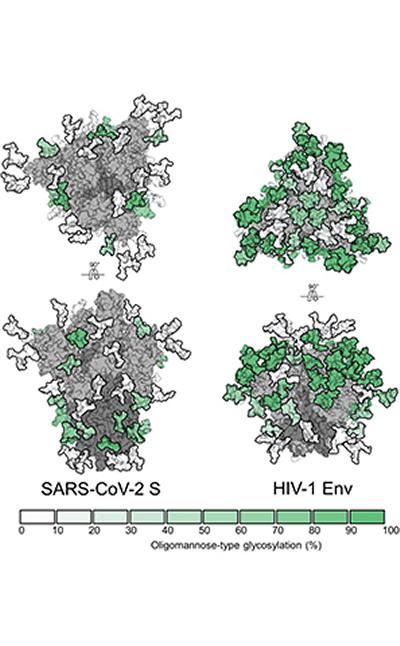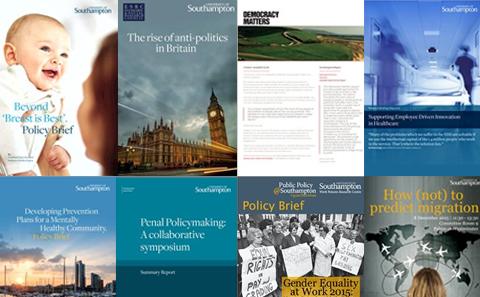
Policy Projects
Find out more about research projects Public Policy|Southampton are currently working with

Max Crispin, Professor of Glycobiology within Biological Sciences at the University of Southampton and his team have recently undertaken research to map the sugars attached to SARS-CoV-2's spike. Their findings have been recently published in Science and the project has been recently referenced in the Royal Society of Chemistry submission to the House of Lords Science & Technology Select Committee.
The emergence of the betacoronavirus, SARS-CoV-2, the causative agent of COVID-19, represents a significant threat to global human health. Vaccine development is focused on the principal target of the humoral immune response, the spike (S) glycoprotein, which mediates cell entry and membrane fusion.
By using a site-specific mass spectrometric approach Prof Crispin and his team were able to reveal the glycan structures on a recombinant SARSCoV-2 S immunogen. This analysis enabled mapping of the glycan-processing states across the trimeric viral spike. The research showed how SARS-CoV-2 S glycans differ from typical host glycan processing, which may have implications in viral pathobiology and vaccine design. Furthermore, they have identified the location of 22 'glycosylation sites' where glycans are attached to the spike (66 in total as the protein consists of three identical parts) and the types of sugar at each site. The details of the glycans were then mapped onto the structure of the spike protein.

In vaccines, immune responses, such as prompting the production of an antibody that would confer immunity to disease, are often generated by a molecule which acts as an active agent: an 'immunogen'. The latter’s effectiveness can be influenced by sugars. In a COVID-19 vaccine, the SARS-CoV-2 spike could be mimicked through an artificial protein acting as the immunogen. And the immunogen might not produce an appropriate response to neutralize the coronavirus itself if its 'native' structure were ruined – a phenomenon that can be monitored by studying the arrangement of glycans. Understanding the glycosylation of the native-like protein is really important because it helps benchmark potential vaccine candidates.
Professor Crispin believes the biological causes and effects of the disease would be better understood through studying SARS-CoV-2's glycan shield, such as which sugars are added in different human cells.

Prof Crispin has been collaborating with the team of researchers at the University of Birmingham led by Dr Alex Richter and Prof Adam Cunningham to develop an assay, which would allow detection of antibodies via a test.
The native-like protein provided by Prof Crispin and his team was made possible by the collaboration with US partner, Prof Jason McLellan who was co-author on the recent paper in Science. In a head-to-head comparative ELISA against other commercially purchased SARS-CoV-2 proteins, including the S1 component of the protein, the use of the viral spike protein manufactured in Southampton showed clear advantages over these alternative proteins in detecting antibodies in subjects with mild and severe disease.
Because of this, native-like protein has improved the sensitivity of an ELISA assay developed to detect SARS-CoV-2 infected individuals. This includes the detection of infection in individuals as early as 2 days after the onset of symptoms and in individuals who have tested positive by PCR but never experienced symptoms.
The Birmingham team have been using Prof Crispin’s S antigen as the target antigen in an assay currently adapted for commercial use. The large scale production of plates for this assay is now well underway, and this will accelerate as more antigen becomes available. This assay has been used to detect antibody responses in >500 sera and a study examining the seroconversion of healthcare workers at Birmingham has been submitted for publication.
The quality of the protein manufactured by Prof Crispin and his team has enabled an effective diagnostic assay to be developed by the Birmingham team that is both highly sensitive and specific.

Up to 100 children in the UK have been affected by a rare inflammatory disease linked to the SARS-CoV-2 virus. Scientists couldn’t initially verify that this rare disease was linked to COVID-19, as most of children tested negative for SARS-CoV-2 by PCR, the test that is used to diagnose active COVID-19 infection in conjunction with clinical presentation.
However, a team of researchers at the University of Birmingham led by Dr Alex Richter and Prof Adam Cunningham have used an ELISA test against the viral spike protein and detected that all children had antibody against the SARS-CoV-2 spike protein. This precise diagnostic test for the presence of antibodies demonstrated that children, who tested PCR-negative for the virus, tested later positive for the presence of antibodies, thus confirming that the new inflammatory reaction occurred following SARS-CoV-2 infection. Notably, the success of the ELISA test was enabled by the quality of the spike protein (S antigen), developed by Prof Max Crispin.
The results further indicated that children had been infected multiple weeks prior to developping the syndrome and that it occurs well after the virus is cleared, which implies that the disease is largely immune-mediated. This new condition has recently been termed Paediatric Inflammatory Multi-System Syndrome - Temporally associated with SARS-CoV-2 (PIMS-TS) and indicates, for the first time, that serology can be an appropriate diagnostic tool in select patient groups.
The testing represents a collaborative effort between the University of Birmingham and the Birmingham Women’s and Children’s Hospital and University Hospitals Birmingham NHS Foundation Trusts. These latest findings have been submitted for publication.

Find out more about research projects Public Policy|Southampton are currently working with

Read policy briefs from recent research projects